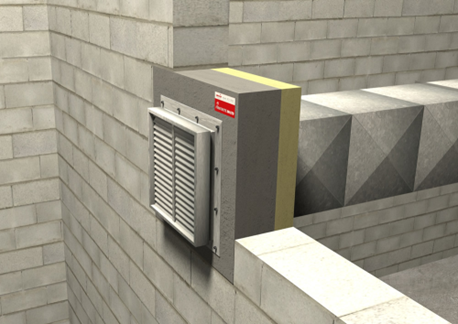
What is a fire damper?
A Fire Damper is essentially a fire safety metal curtain device that falls within your buildings air ventilation ductwork systems. They are lifesaving pieces of equipment and a vital part of a buildings fire safety, designed to help contain a fire within a certain zone for a period of time. Fire dampers are essential and make it easy for building occupants to evacuate the building as well as fire fighters to reach the blaze that has been kept within a contained area of the building. The idea of compartmentation is to keep the fire in the start point and prevent it from spreading to other locations. As the vents are strategically positioned at various places within the building, this also allows the ductwork to pass through fire compartment walls, floors or zones within the building.
How does a fire damper work?
Dampers are located in ductwork and ceiling cavities. Should a fire break out, they’re designed to close when the temperature in the room or space rises over the threshold limit, and so suppress the spread of smoke and fire throughout the building. Fire dampers have a fusible link, which is selected according to the desired temperature and once this temperature is reached, the damper closes.
The damper itself can be electrically actuated, pneumatic or manually set. In electric and pneumatic actuated dampers, fusible link releases and cuts off operating voltage to the spring return motor, allowing the spring to close the damper blades. The fire damper opens automatically when the fuse has been changed and the operating voltage to the motor is re-established. In spring operated dampers, fusible link releases allowing the spring to close the damper blades. When the fuse has been changed, the fire damper must be reset into open position manually.
Types of Fire Dampers
Fire itself is not the only threat in fire related accidents. Smoke and other gases released in the fire can pose a great danger to people especially in environments where different chemicals are being produced or stored. These gases spread fast and depending on the substance, even small doses can be extremely dangerous or fatal to people. Special seals can be used in fire dampers to obtain gas tightness to stop these harmful gases from spreading in addition to fire protection.
There are quite a few different types of dampers and each one is required depending on the risks your building poses.
Dynamic – installed in vertical barriers, these particular fire dampers have a spring-loaded mechanism. In case of fire, the mechanism is released, and the doors of the damper shut close. The fan in the system will continue to run and build up pressure. This pressure will help keep the fire dampers’ doors closed.
Static – installed in horizontal barriers, these fire dampers have a curtain-like design. In case of a fire, the curtain drops, preventing passage for heat, flames and smoke. These dampers are installed where ducting fans will no longer work if a fire is detected.
Fire/Smoke – A combination of fire and smoke dampers are widely considered to offer the best of both when it comes to protecting occupants of a building and the building itself. These types of dampers are essentially what it says in the name – they are designed to block both fire and smoke. They are utilised when a duct is required to have a fire damper and a smoke damper, and either high temperature or smoke detection is the trigger for closure. Unlike fire dampers, combination dampers do not have a fusible link, but rather, once triggered, operate on an electronic release. This closes the damper more slowly and prevents pressure problems in HVAC systems
Smoke dampers
Smoke dampers respond to the detection of smoke, and close automatically. They can also be activated remotely. They resist the passage of smoke, toxic gases and air through a fire barrier. In the event of fire, the largest cause of death is inhalation of smoke and toxic gases, and so containing those things, for at least as long as it takes for the building to be evacuated, is essential.
